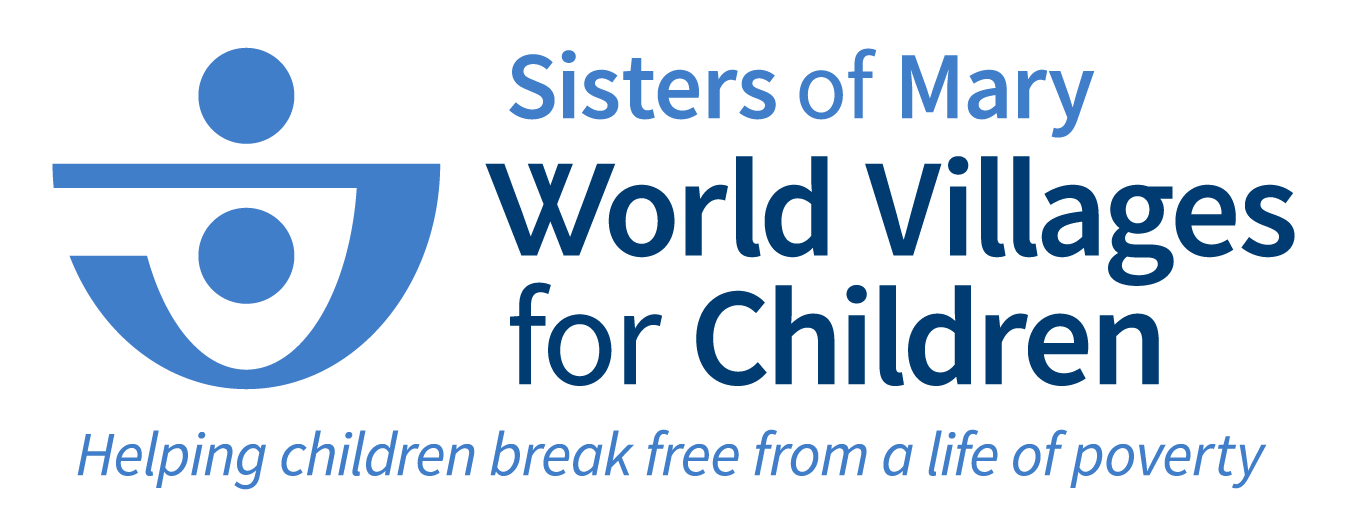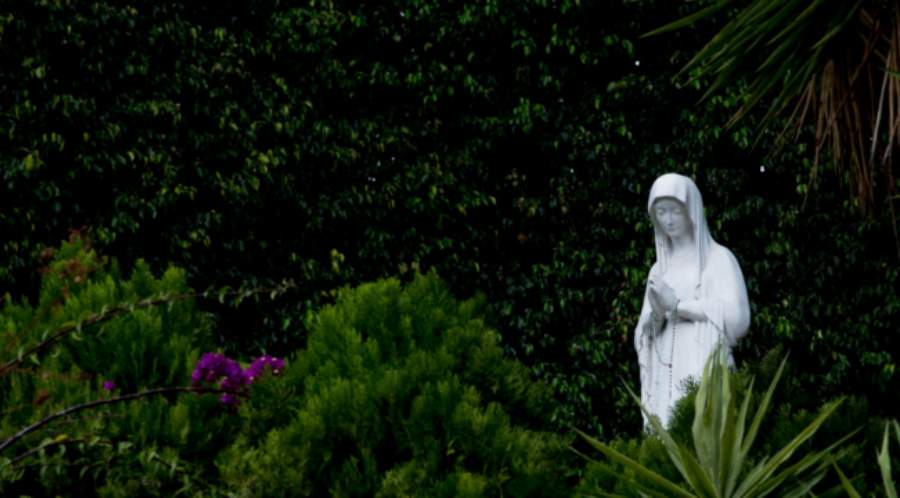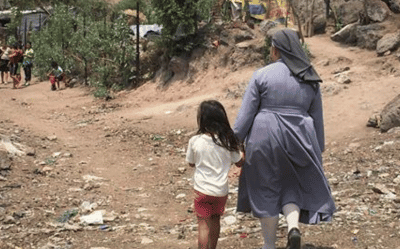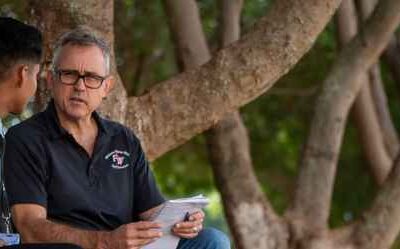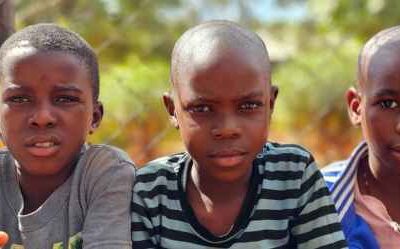Today marks the 91st anniversary of an event that led to one of the greatest movements of rescue of the poor, humiliated, and rejected in the history of the world. When the Blessed Mother visited a 13-year-old peasant girl in a tiny frozen-over Belgian village, the long-suffering fate of the universe of the forgotten ones began to shift.
As the Catholic Church calls to mind the poverty-stricken during Poverty Awareness Month, it is fitting to tell the story of the incomprehensible – but very true – events that unfolded when Our Lady visited a poor girl named Mariette Beco on a moonless winter night in 1933. Mary spoke just 91 words in her eight visits to the backwater of Banneux, Belgium. But it was those words – courteously spoken in a manner suited for a country girl – that spurred one of the greatest accounts in Church history of Our Lady’s intermediary work through a single man—Washington D.C. native Venerable Aloysius Schwartz.
 It can be argued that because Mary came to Banneux – and because Mariette listened to and obliged her commands – more than 175,000 children have been saved from a life of poverty, violence and even death and trafficking over the past half-century. Also, because of those Marian visits, it can be argued that more than 380 sisters asked God in a chapel before dawn today to increase their stamina, joy, and sacrifice to properly love 20,000 of the most bullied children in the world in Boystown and Girlstown communities throughout the world.
It can be argued that because Mary came to Banneux – and because Mariette listened to and obliged her commands – more than 175,000 children have been saved from a life of poverty, violence and even death and trafficking over the past half-century. Also, because of those Marian visits, it can be argued that more than 380 sisters asked God in a chapel before dawn today to increase their stamina, joy, and sacrifice to properly love 20,000 of the most bullied children in the world in Boystown and Girlstown communities throughout the world.
Though the apparitions of Banneux have been approved by the Church, they are barely known. But what follows is the story of how Our Lady of Banneux—or the
Virgin or the Poor—worked through a lonely seminarian to change the course of the world by making a promise to his Queen.
The extraordinary event sparked to life among a population of villagers that had abandoned the Catholic faith after World War I. Within a year, each of the approximately 300 souls in Banneux came roaring back to the sacraments and to the Sunday church bells they had routinely ignored.
Banneux was not unlike other country villages throughout Europe in the 1930s, a time when indifference to the Catholic faith spread along with the push for industrialization in cities. It was the unspoken mental stain of the townsfolk; they knew where they were supposed to be on Sunday; they just didn’t seem to care. The situation was especially egregious in light of the town’s then-recent history. In 1914, the villagers made a collective vow to consecrate Banneux to Our Lady if she would spread her mantle over their town when German soldiers began their Belgian routes during World War I. Banneux townsfolk never heard a single rifle shot.
So Mary came and spoke to a girl with an open heart.
Mariette had a reputation for being a sweet and caring child who looked after her many little brothers and sisters. Similar to the children to whom Our Lady chose to appear at her apparitions in Fatima, La Salette, and Lourdes, Mary seemed to choose Mariette simply because she was poor, pure, and humble. The apparitions began when Mariette noticed a glow in her own front yard. It shone on Sunday, January 15, 1933, a frigid and windy evening. She knelt from a wooden bench in the small parlor and pressed her nose against a frosty window pane in her house.
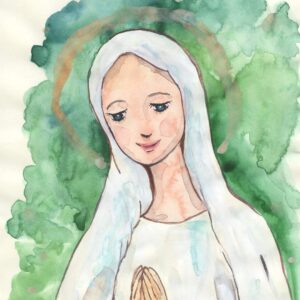 A “bright ball” like the moon passed through pine trees and began to move toward the Beco home, gradually taking on the silhouette of an exceedingly beautiful woman. She was a little over five feet in height and hovered a few feet above the ground just outside the window. The image looked directly at Mariette. She was smiling. No one else in the home was the wiser as to what was unfolding.
A “bright ball” like the moon passed through pine trees and began to move toward the Beco home, gradually taking on the silhouette of an exceedingly beautiful woman. She was a little over five feet in height and hovered a few feet above the ground just outside the window. The image looked directly at Mariette. She was smiling. No one else in the home was the wiser as to what was unfolding.
She appeared as a vision of radiant light, clothed in a white garment above a blanket of snow, where an onion patch would bloom in the springtime. She stood in a posture of motherly love, her head slightly inclined to the left. After gawking at the luminosity of the image for several minutes, Mariette thought to place the oil lamp into another room, imagining a reflected play of light was being cast. But the image of the beautiful woman remained, even brighter. When she bolted for the door to greet the woman, explaining to those she passed what she had seen, her mother told her to remain inside because of the darkness and cold. Superstitions were widespread in the Belgian countryside towns of those days, and her mother lazily attributed the glow to that of a witch. Thereafter, the light from the front yard became extinguished.
Mariette went to her room later that night and began to pray the Rosary. It would mark her return to the practice of the faith. She began to attend weekday Mass, seek catechism instruction, and practice habits of virtue and piety.
Three days later, Mary returned. It is the mystique of this second apparition, perhaps more than any of the eight, that captivated and motivated Fr. Al Schwartz’s priesthood. With a tender expression of maternal love, Mary smiled and coaxed Mariette, who had been seeking Our Lady in temperatures that had dropped into the teens, to a point in her yard where a deep forest met the Beco’s property line. As she began to walk into the night illuminated by the moon, Mariette’s father, who had seen her puzzling behavior from indoors, raced outside for her. Thereafter, he watched his daughter drop like a stone onto the frozen ground on three separate occasions, where she knelt for a sustained period and appeared to look up into a point in space. She seemed irradiated, completely absorbed, he thought, in a supernatural trance. About 125 yards from their home, he watched Mariette kneel by a previously unnoticed spring. He was too afraid to speak when she plunged her hands into the icy water. He didn’t know that she was obliging the odd command of Mary, who had asked Mariette to “plunge your hands into this water. … The spring is reserved for me.” Mariette kept her hands submerged for a sustained period of time. When she released her reddened hands from the spring, she began to follow Mary down a narrow road. Her father asked, “Where are you going?” to which Mariette responded: She calls me. It was then that her father, who could not see the vision, raced out to find the parish priest at his rectory. Within days Julien, too, would return to the full practice of the Catholic faith.
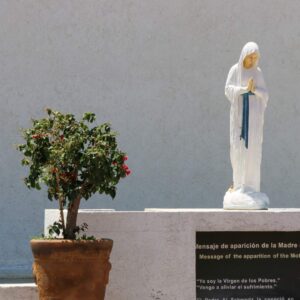 A few nights later, Mary introduced herself to Mariette as “The Virgin of the Poor,” the first time in the history of apparitions that she had identified herself with those living in poverty. In the days that followed, the Blessed Mother told Mariette she had come to alleviate the sufferings of the poor and broken-spirited, while emphasizing the need for unceasing prayer.
A few nights later, Mary introduced herself to Mariette as “The Virgin of the Poor,” the first time in the history of apparitions that she had identified herself with those living in poverty. In the days that followed, the Blessed Mother told Mariette she had come to alleviate the sufferings of the poor and broken-spirited, while emphasizing the need for unceasing prayer.
In effect, Mary’s words to Mariette acted for the American missionary priest – who discovered the apparitions while studying at the University of Louvain in the 1950s – as the raw material to build the perhaps the broadest non-governmentally-funded service for poor children and orphans in the history of the world. Everything mentioned to Mariette, in a sense, was stolen, contemplated, mentally engineered, and effectuated by Fr. Al, who during the early years of his priesthood, began to spend unmeasured hours in contemplation of Mary’s few words to the young girl.
Early in his priesthood in Busan, South Korea, Fr. Al began to turn over in his head the messages from Mary’s eight apparitions. His thoughts, ruminations, and inspirations would eventually emerge as a holy system that would bestow incomprehensible inheritances on generations of the poverty-stricken and humiliated. Hundreds of thousands of the poorest people in the world would be given new life because “Fr. Al” obliged Mary’s words to “alleviate sufferings.”
As a seminarian – in the midst of battling prolonged illnesses, a language barrier, persistently miserable weather, and a concentration camp-scarred seminary rector – Fr. Al was drawn to the apparition site two hours from his seminary. Fr. Al was the lone American seminarian with the Société des Auxiliaires des Mission (the Samists)—and he found it a joyful escape to travel southeast by train through Belgium’s green-blanketed farming communities to reach tiny Banneux. The town is so small that many Belgian mapmakers don’t even include it. But the town drew Al, in the manner a sunflower bends to the sun’s rays. By the time he was in his second year at the Catholic University of Louvain, Banneux had become a part of his soul. He desired total union with Mary, who rose in him there like a small flame of consolation during his tough seminary days.
Before he returned to America to become ordained in the summer of 1957, Al caught a train to Banneux one last time where he gave Mary his life—at the same spot where she appeared to 13-year-old Mariette Beco twenty-four years earlier. He vowed to Mary that everything he did in the days that followed would be as her slave. It could be argued, with great success, that the language of heaven that Mary brought to the peasant Mariette was designed not for her, but for the seminarian, Al, who is now on the path to canonization.
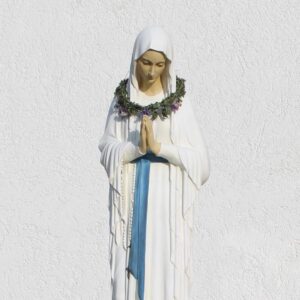 Under the banner of his spiritual muse, Fr. Al fashioned an integrated system of authentically Catholic temporal and spiritual care for countless poor children,
Under the banner of his spiritual muse, Fr. Al fashioned an integrated system of authentically Catholic temporal and spiritual care for countless poor children,
who he would provide an education, housing, meals, medical care, catechesis, the sacraments, vocational job training, sports teams, orchestras, and other extracurricular activities for a five-year time span. Because of Fr. Al and his vow to Our Lady, today there are 17 Catholic Boystowns and Girlstowns throughout the world. Each is run by the Sisters of Mary, the order Fr. Al founded on the Feast of the Assumption in 1964.
After pledging his priesthood to Mary—and surrendering to her all of its future merits—Fr. Al left Banneux forever, uncomprehending of all the Mother of God would do through him, his intermediator. Today, thousands of teenage students are being cared for by the Sisters of Mary, which today are in the Philippines, Mexico, Brazil, Honduras, Guatemala and Tanzania, Africa. Some of the poorest children in the world have graduated to run companies, become orchestral musicians, mechanics, instructors, lawyers, professional athletes, priests, nuns, and take on hundreds of other jobs.
Importantly, at graduation, the Sisters send the teenagers back out into the world as Catholic missionaries seemingly raised from the grave. Fr. Al knew that when poverty-ravaged orphans came to know God’s unique love for them, that they would be reborn. That’s what Mary did for Mariette—and that’s what Fr. Al is still accomplishing today through the Sisters of Mary.
“People say that St. Vincent de Paul was the great apostle of charity and that Fr. Al Schwartz based his entire missionary life on his,” Monsignor James Golasinski said. “But I’ve told people that Msgr. Aloysius Schwartz accomplished more than St. Vincent de Paul. What Fr. Al managed to do is beyond the pale. I was there and I saw what happened.”
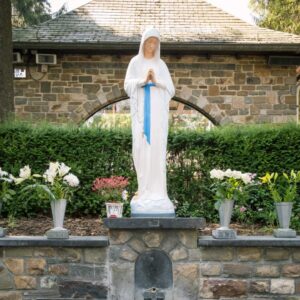 Msgr. Golasinski is referring to the time he spent in South Korea, where Fr. Al got his start in the priesthood after leaving Belgium. Fr. Al, who died at the age of 62 from Lou Gehrig’s Disease in 1992, built his first Boystown in Busan, Korea in 1969.
Msgr. Golasinski is referring to the time he spent in South Korea, where Fr. Al got his start in the priesthood after leaving Belgium. Fr. Al, who died at the age of 62 from Lou Gehrig’s Disease in 1992, built his first Boystown in Busan, Korea in 1969.
Just before dying, Fr. Al wrote:
Mary of Banneux chose me at an early age just as she erupted in the night in the life of Mariette Beco. She suddenly appeared in my life without any preparation. She brought me to Belgium where I discovered her. I never heard of Banneux before then. So my priesthood in a special way belongs to Our Lady of Banneux. My apostolate is hers and I would like to be buried at her feet and say, that, all praise, glory, and honor for anything good accomplished in my life goes to her and her alone.
